Dispatch 9
Date: June 21, 2001. Thursday.
Location: Nanchang, Jiangxi Province
Greetings once more from Nanchang. We had some free time this morning away from our group, so we called a local contact whom we’d been invited to look up once we were here. Dr. Qu Zu Yi is a delightful man, a teaching physician and epidemiologist whose specialty is hepatitis, Chief Director of the Jiangxi English Institute, and — the icing on the cake — an avid birder and photographer. We had actually called him up late Wednesday and are spending time with him and his wife off and on throughout our stay in Nanchang (we leave Saturday afternoon). Today he took us to an absolutely amazing place.
On the edge of Nanchang there is a small park and temple complex, not terribly old.
Over the course of the last 10 years or so, very sizeable migratory colonies of egrets, herons, and various other waterfowl have taken up residence within the boundaries of this park. Since we share the joy of birding, Dr. Qu generously took off the morning and had his driver take the four of us to the park to admire the many hundreds of birds who are making their annual stopover. There were a few species that we recognized, but many we did not–the density was stunning. In this photo, Susannah spies a kind of egret that has a reddish head, a bluish shawl, and a comically long beak. We’ll try to identify it in our Sibley book once we get home. We don’t have a clue what it is otherwise.
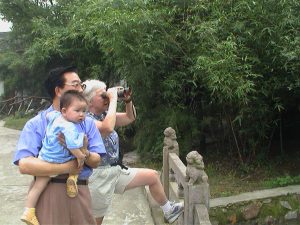
As we mentioned above, Dr. Qu is also a photographer and member of a birdwatching society based at the park that was sponsoring a display in a nearby pond-side pavilion. Susannah wants those of you who are not familiar with the limitations of 35-mm cameras to appreciate how impressive it is that he could produce such sharp, balanced color enlargements considering that he does no darkroom manipulation whatsoever. He clearly has the eye of an artist–and the skill of a professional. Here he’s standing beneath two of his works.
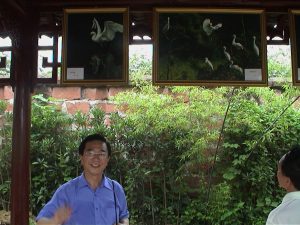
We are settling into a routine with Elle that includes her late morning nap, in addition to prepararations for the afternoon’s trip and final Nanchang paperwork, so we parted from Dr. Qu at lunchtime.
Remember the other day when we said that the people in Nanchang seemed to be very poor but dignified? That goes DOUBLY after this afternoon’s outing. TRIPLY, even. Our adoption agency coordinators feel that it is important for us all to go out into the countryside to see how the vast majority of the Chinese people live. More than 75% of Chinese people live in small farming villages, in one or two story structures. Heretofore, our experience had been of China’s cities. In China, the differences between city and village are breathtakingly extreme, and our coordinators wanted us to see it first hand.
They piled us all onto two modern Toyota buses, air conditioned and with comfy seats. Then they drove us along a dirt road that followed the Gan River north of town. The buses had to crawl because the roads were full of potholes the size of Volkswagens. Trucks were passing us on the left AND the right. Oncoming traffic was a fright. Bicycles were thrown into the crazy mix as well. Oh yes, it also was raining lightly and the road was very muddy. Many of us on the bus wondered whether we were going to have to get out and push. Seriously.
But we didn’t. After what might have been a mere 10 minute drive away from the bustle of Nanchang had we been on a paved road, we arrived at Jin Village.
This is a farming community of perhaps 400 men, women, children, ducks, pigs, and chickens. There is a single two-story building, the rest being single-story brick wall sheds with slate and thatch roofs; the lanes are basically mud with a generous helping of human and animal waste mixed in. Ducks and chickens roam the streets scrabbling for something to eat before it is their turn to be eaten.
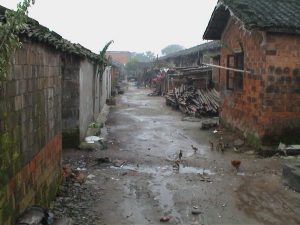
We started out feeling very uncomfortable walking into these peoples’ homes like spectators. But to our amazement, it seemed we constituted an event in our turn–an event they were clearly enjoying. They welcomed us into their homes warmly and without embarrassment.
Picture a bunch of healthy, big Americans with nice, well-kept clothing and haircuts traipsing through mud-floor, wood-heated huts. We all had our video cameras whirring as we poked our heads into each room, looked at their cooking, washing, and storage areas, switched to night vision as the darkness warranted.
In the picture below you can see a woman holding a baby and smiling the warmest of smiles, though the baby didn’t know what to make of us. The photo was taken using night vision since there were no electric lights nor oil lamps in use. The village got electricity about 20 years ago, very early in the electrification project since they are so close to Nanchang. It’s not reliable yet very expensive, so they conserve it. The only electric appliance in evidence was a banged up ceiling fan. Suspended from it was a contraption for storing food off the floor and away from the rats.
In the cart to the woman’s right sits a bowl of noodle dough. The water for making another batch is in a bowl across the room. There are chickens pecking around her bare feet on the dirt floor. The family’s extra clothing (meaning, what’s not on their backs or in the wash at the moment) and an umbrella hang behind her. In her other room, there is a freestanding brick fireplace, a wok, a Brillo ™ pad, and a pile of straw and wood for kindling. The back wall opens directly into the mud alleyway without a door.
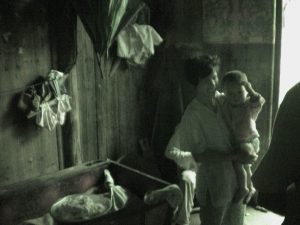
This woman was so friendly and welcoming of us Americans into her home. She and all of the others we met greeted us with such dignity and warmth. It was an astonishing and humbling experience.
The other members of the village were similarly friendly and were particularly interested in Robert’s beard. Robert walked beyond the home pictured above, past the pigsty, and into a sort of community hall where people were playing cards and mah jong. The man in the photo below came up to Robert and, using international sign language or whatever, asked Robert if he could please touch his beard. Robert obliged and took this photo immediately after the laying on of hands. Note the two boys interested in the whole transaction and looking on.
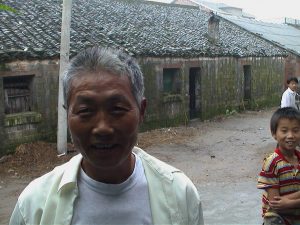
Between the beard and the digital video/still camera with night vision people started to get really interested in the strange alien creature who had landed in their midst. The menfolk left their cards and mah jong games and came out to see what the hullaballoo was. By this time, Robert turned the LCD display of the camera so that they could see themselves in the photos. This brought loud laughter and gleeful expressions.
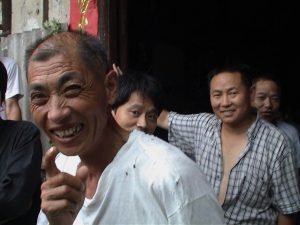
For his next trick Robert put the camera on a timer and held it at arm’s length to snap a photo of himself and the whole crowd. This was SUCH a hit with these warm and gentle people that many of them wanted to take a turn at the camera. Robert handed it around with some attempt at explaining the different modes (video versus still), how to operate it (this button versus that button), and some other instructions that turned out to be unnecessary. They fumbled with buttons and managed to accidentally take a few photo close ups of Robert’s shirt as well as some video of the sky. But they had a blast doing so, and that was the important part.
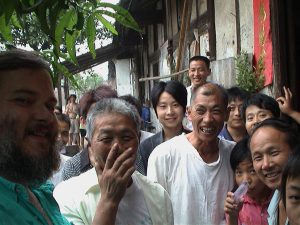
And then came the kicker. Literally. Robert wears size 14 shoes. The boy has big feet, there’s no doubt about it. One of the villagers noticed the size of Robert’s feet, and the jig was up. At least two dozen people put their feet next to Robert’s, one after the other, and compared foot sizes. At each comparison, the crowd laughed and burst into a discussion that sounded like henhouse chatter. Someone would motion to go get so-and-so so he could compare foot sizes with Robert.
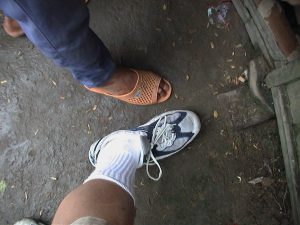
Ultimately, it was time to get back on the spaceship and head back to planet earth. The adoption agency coordinators had made their point quite well. They wanted us to know why Chinese people are so thankful to us, not only for adopting their abandoned children but also for donating money to the Social Welfare Institutes. They wanted us to know the living situations of the majority of the Chinese people and that our donations to the orphanages really do make a difference, by providing clean, safe housing to the children who will remain in China back at the orphanage.
We are profoundly humbled by this experience.
We drove back into Nanchang and the group divided. While Susannah went to the police station to pick up Elle’s Chinese passport and exit permit (yeah! — she can now legally leave China!), Robert and Elle went shopping for Elle shoes in a department store that could have been in Kansas City, MO, were it not for the Chinese signs and money.
Oh, and the Chinese style toilets. It is astounding how close Jin Village is to the Kentucky Fried Chicken and shopping mall that sits across the street from August 1 Square. And yet, how it remains light years away in so many respects. China and its 1.3 billion people have come so far since the reforms of 1978, but they have so far to go yet. At least for the 25% of the population that lives in cities, life is as modern as you can expect anywhere. These sales persons were typical of the Chinese ladies who tickle and coo at babies who walk past their stations. Elle couldn’t escape their clutches, so she went along with it for a minute.
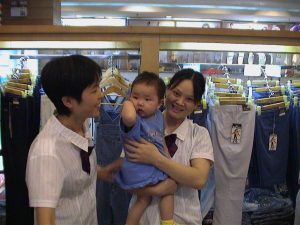
But only for a minute. Open arms from Dad called her back to her perch in his arms, and we all went off to a nice restaurant in downtown Nanchang.
Two more days in Nanchang, then off to Guangzhou.
Regards,
Robert & Susannah / http://eleanorjean.com